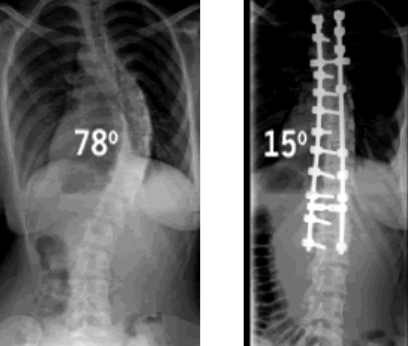Scoliosis is a spinal deformity that affects all three planes of the spine. It occurs in children and adults. Some people are born with the condition and others develop it at later stages of life. Neurologic and muscular diseases, such as cerebral palsy and muscular dystrophy, can also cause scoliosis.
If you or your child has scoliosis, you may be wondering what kind of treatments are available, including spinal surgeries. In some cases, more conservative treatments may be available.
What does scoliosis look like?
When the spine has “normal” alignment, the spinous processes — or the protruding bony parts on the back of the spine — line up in a straight line over the sacrum, or the vertebra at the bottom of the spine. Different types of scoliosis can include these features:
- Lateral displacement
- Rotational displacement
- Angular displacement
- Saggital displacement
- Curves within curves
- Major curve
- Minor curve, or an effort of the body to correct for the major curve
Curves may have varying degrees of stiffness and cause other issues, such as a rib hump. The exact nature of the displacement and curves — as well as the patient’s age and other conditions — will affect what kind of treatment is necessary. An orthopedic expert can help explain your condition and the types of treatments that make sense.
When is observation and bracing a treatment option?
Some cases of scoliosis can be treated through just observation or bracing, while others may require spinal surgeries.
Most patients with scoliosis have small curves. The greater the degree of curve, the more likely the progression of the condition. The greater the amount of growth after the onset of the curve, the more likely the progression.
Curves of less than 25 degrees generally can be treated by an orthopedic specialist with observation and regular radiographs to track progress.
Curves that range from 25 to 40 degrees with flexibility can often be treated with bracing. Curves from 40 to 50 may also be treated with bracing. There is a high noncompliance rate in cases where curves are 20 to 25 percent and have a rapid rate of progression.
When are surgeries for scoliosis needed?
Treatment for some people with scoliosis will require one strategy, but some will require a combination of strategies, which may include spinal surgery. The stiffness of a curve will influence the strategy in cases where surgery for scoliosis are needed. Different methods of surgery can come with different pros and cons. Some spinal surgeries rely on hardware like bars rods, or bolts and others cables. Talk to your orthopedic specialist about which procedure will work best for any spine disorders you or your child may have.
Some potential pros of different spinal surgeries for treating scoliosis can be:
- Can correct lateral and angular displacement
- Can correct lateral and rotational deformity
- Low profile
- Inexpensive
- Simple and quick
- Comprehensive
- Lower stress on bones and hardware means that smaller rods and lower profile connectors can be used
Some potential cons can be:
- High stress on bones and hardware
- Straight rod means a straight spine or“flat back”
- Does not correct rotational deformity
- Long-term maintenance of correction is difficult
- Difficult over long curves
- Difficult with titanium rods
- Complex
High stress to bones and hardware can be one of the common cons of many procedures. Talk to an orthopedic surgeon about how to approach different types of scoliosis.
For more resources on spinal surgeries, check out innovations in spine surgery and the most frequently asked questions about spine surgery.
If you’re going to have spinal surgery, there are steps you can take to be prepared for a successful procedure and recovery.

